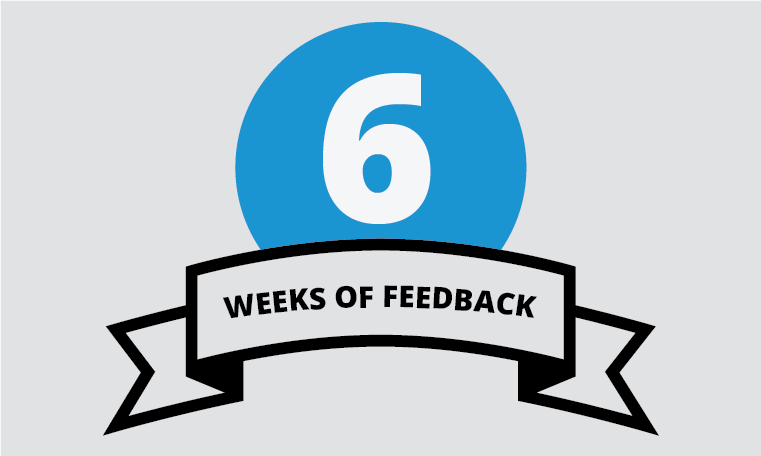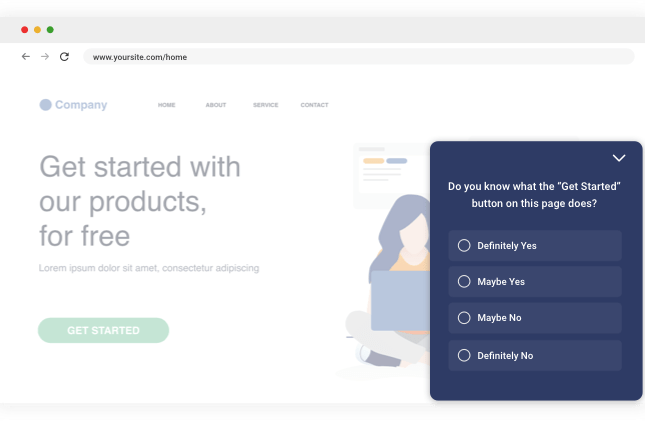If you’ve spent hours wondering how to maximize the ROI on your survey strategy then here’s one word that can make a huge difference for you.
The word is – Relevance.
Would you like to receive surveys that don’t make sense when you are halfway through answering them?
You don’t. Neither do we.
Nor do your customers.
Despite knowing this, one of the biggest challenges that businesses face is creating surveys that are relevant.
Each respondent is different, so how can you create a survey that is relevant to all of them? You cannot show multiple surveys to the visitors. It will only frustrate them, leading to survey abandonment and loss of potential sales.
Even in an individual survey question, each respondent can choose a different answer. So, how would you tailor a survey that considers the previous responses to show only relevant questions to the respondents?
Using skip logic is the answer.
It lets you design personalized surveys that ask the right questions to the right respondents to collect insights that you can act upon. It improves customers’ survey experience to help you gather unique feedback and reliable data points from different visitor perspectives.
In this blog, we will explain the concepts of skip logic and understand its need in surveys. We will also shed light on creating surveys with skip logic or conditional branching so you can extract the intended feedback from different audience segments using the same survey.
What Is Survey Skip Logic or Conditional Branching?
Survey skip logic, also called branch logic, takes advantage of conditional branching to direct the respondent to the next logical question based on their previous answer and skip other non-relevant questions. You can choose which question will appear before the respondent depending on their response while designing your survey.
What is conditional branching?
Conditional branching lets users skip the screens in a survey if certain predefined conditions are being met. Also known as question logic, branch logic, branching, survey routing or disqualify logic, this lets you create a customized pathway through which a respondent can proceed based on their answers. This helps in creating an efficient survey as respondents only answer the relevant questions.
Survey fatigue is a real thing. The customers are constantly bombarded with survey feedback, subscription mails, lead forms, etc., in their message box, inbox, phone calls, social media, WhatsApp, etc.
You have a tiny window to engage your target audience. So you need a mechanism that personalizes your surveys to gather specific inputs from different customer types. That is where survey skip logic comes into play.
How Does Survey Branching Work?
It helps you create intelligent surveys that allow the respondent to take a custom path depending on their answers to provide a more focused and in-depth understanding of their behavior or experience.
In this way, the respondents would only see relevant questions and skip the others. Let’s understand this with a simple example.
Suppose you want to deploy an NPS survey on your website. An NPS survey’s standard structure contains a question, and the response anchor is an 11 point scale ranging from 0-10. These are divided into three categories, i.e., detractors (0-6), passives (7-8), and promoters (9-10).
However, without survey branching, you can only add a common follow-up question irrespective of the answer, such as ‘please specify the reason for your response.’

Now, let’s see how the skip logic can design a truly personalized survey that appears empathetic towards the respondents by allowing you to add questions that reflect their sentiments.
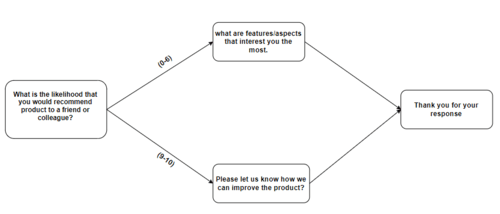
As you can see in the image above, the follow-up questions resonate with the type of response selected by the respondent.
If the respondent selects a lower rating (0-6), he is directed to the question added to this response anchor as the next question branch.
For example, “Please let us know how we can improve the product?”
If they select a higher rating (9-10), you can ask a different question:
“What are features/aspects that interest you the most?”
With skip logic, you can have more in-depth insights into different respondents’ behavior using the same survey. Today, most of the survey tools provide skip-logic or question branching features in their software. So you don’t have to write any line of code to deploy it.
Generally, you need to select the response anchor and set the question that you want the respondent to see if they choose that particular answer.
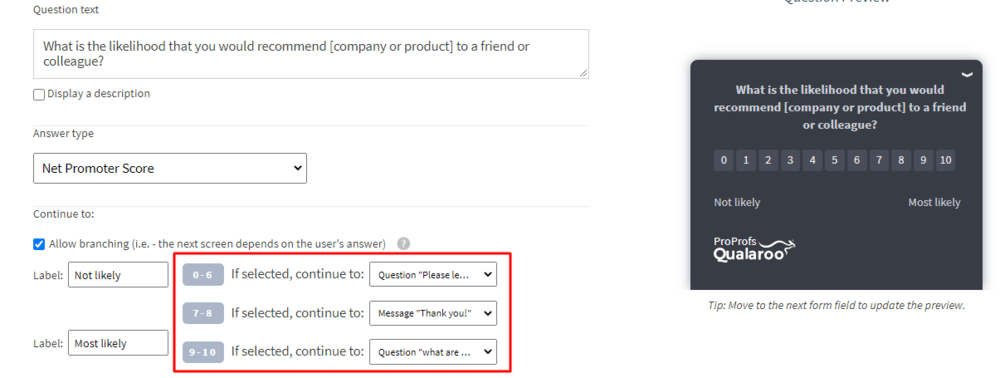
For skip logic to work, each response is linked to the next logical question, which may or may not be different. You need to make sure that each path created by such branching is complete and consistent so that the conditional branching survey flow does not break at any point.
Types of Survey Skip Logic or Branching Logic
A survey can have different flows depending on the skip logic or branching utilized at each question. A conventional linear survey usually moves from initial or first question to last question/screen, taking the respondent through all the questions without skipping any of them as shown in the figure below:

However, with the introduction of skip logic, the branching can be of two types: conditional and unconditional branching.
1.) Conditional Branching
In conditional branching, the next step is based on the type of condition met on the current action.
It means that the respondents’ chosen answer will decide the next question that appears before them.
With conditional branching, each response anchor can help you create a different path for the respondent. It may take them to another question or directly take them to the survey’s end, skipping other irrelevant questions.
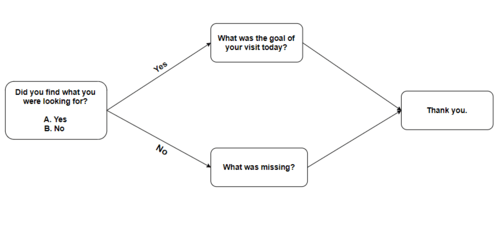
2.) Unconditional Branching
In contrast, unconditional branching takes the respondents to the same question irrespective of their response to the current question.
For example, the respondents may see a ‘Thank you’ screen or a lead form irrespective of their answer to the question.
It should be noted that if a respondent is taken to the next immediate question, it is not called unconditional branching. It is just the normal flow of the survey.
The branching type used on different questions is decided during the design phase and implemented while creating the survey. It allows you to configure all the survey paths and make changes as required. A survey may contain both types of branchings depending on the requirement.
Skip-Logic Use Cases: Examples of Branching Questions
You can use skip logic in any imaginable scenario on your surveys. The aim here is to collect as much information as possible from different audience types without annoying them with tedious questions that do not apply to them. Let us look at some of the scenarios that employ survey branching to create personalized questionnaires.
1.) New Product Launches or Product Tweaks
Skip logic can quickly help you evaluate the demand for new upcoming products or gauge what your users think about newly launched products or services. Have you recently introduced entirely new products or updates to the existing ones? Your verified customers will provide thorough feedback about how they feel about the changes than new visitors.
You can use targeting options to collect separate feedback from existing and new customers, but it would require creating two different surveys.
Skip that!
You can simply use skip-logic to collect feedback from your customers and inquire about your products’ interest among new visitors from the same survey.
Example:
- “Are you an existing customer?” Yes or No
- If Yes – “ How satisfied are you with the new features added to the product/service?”
- If No – “Have you ever used the [product/service] or something similar before?” Yes or No
- If Yes – “What are the features that you liked the most in the product?”
- “How was the product helpful to you?”
- “How does this product compare to other products you have used before?”
- If No – “Thank you for taking the survey.”
- If Yes – “What are the features that you liked the most in the product?”
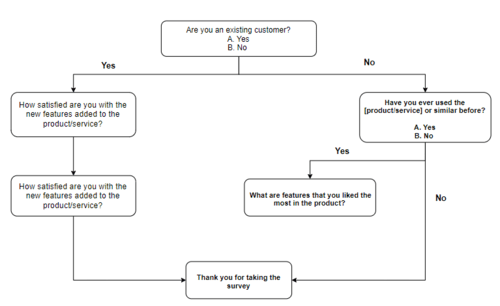
2.) Feedback on Existing Products
Design surveys such as NPS, CES, CSAT, exit-intent survey, etc., and use skip-logic to understand the reason behind the customers’ responses. Each survey branch can tell you a different perspective about the customers’ journey. You can use the feedback to segregate positive and negative experiences to prioritize the latter.
Example of the Branched Exit-Intent Survey:
- “Were you able to find what you were looking for?” Yes or No
- If Yes – “How did your experience [on our website/ in our app] compare to your expectations?”
- If No – “What would you say was missing?”
- “Please tell us how we can improve the product further?”
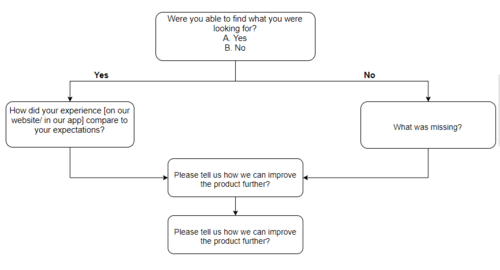
3.) Exploring Product Opportunities
Surveys are the easiest way to find out about users’ expectations and needs from your products. You can gauge if the product meets their expectations or not and gather suggestions about improving it. Here also you can separate satisfied clients from the dissatisfied ones and discover the areas of improvement.
Example of the Branched Survey to Explore Product Opportunities:
- Does this product/software have all the features and functionalities you expected? Yes or No
- If Yes – “Which feature do you like the most?”
- “Is there anything you would like to improve in this product/ software]?”
- If Yes – “Which feature do you like the most?”
- If No – “What was missing?”
- “What feature or aspect frustrates you the most?”
- “What would you like to improve in this product/software?”
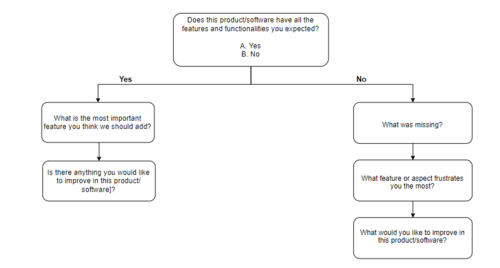
4.) Understanding Customers’ Preferences
What are the usual channels of purchase used by your customers? How often do they shop from your website or store? What are their most purchased/used products?
These are the questions that will help you collect information about your customers’ choices and preferences. Use surveys to understand what drives customers towards your business? What are your most popular products/pages? And much more.
Example of the Survey Using Skip Logic to Understand Customers’ Choices:
- “Do you buy groceries online?” Yes or No
- If Yes – “How often do you shop online for groceries?”
- “What website do you mostly use to buy groceries? Select all options that apply.”
- “What brought you here today?”
- If Yes – “How often do you shop online for groceries?”
- If No – “Why do you not shop online?”
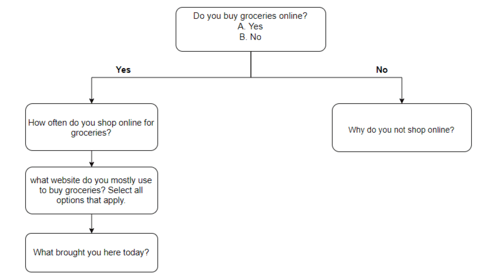
5. ) Event Planning
When planning an event, you can design surveys to gauge the participation level of the people. It can help you do a headcount of the attendees, ask about their needs, and plan activities to engage them.
Example of Event Planning Survey :
- “Are you attending the [event]?” Yes or No
- If Yes – “Would you be interested in the complimentary lunch/ extracurricular activities?” Yes or No
- If Yes – “Please choose from the following activities/ lunch preference?”
- “Thank you for your feedback. Please leave your contact details so we can send the invitation to you.”
- If No – “Thank you for your feedback. Please leave your contact details so we can send the invitation to you.”
- If Yes – “Would you be interested in the complimentary lunch/ extracurricular activities?” Yes or No
- If No – “Please mention the reason for not attending.”
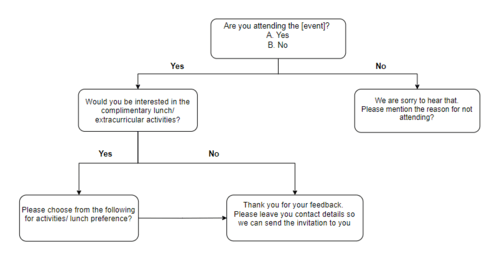
6.) Disqualifying Respondents
Not all visitors are interested in your business. It is important to separate the irrelevant audience from potential prospects and actual users. Using skip logic, you can disqualify the respondents who are not eligible to participate in the survey or fall outside your target audience.
Example of skip logic survey to disqualify respondents:
- “How often do you exercise in a week?”
- A. Everyday
- B. Twice a Week
- C. Thrice a Week
- D. Do not exercise
- If the answer is A, B, or C – “Do you work out at home or the gym?”
- If the answer is D – “Are you looking for a workout plan that suits your daily routine to keep you active?” Yes or No
- If Yes – “Please provide the following information to get started.”
- If No – “Thank you for your response.”
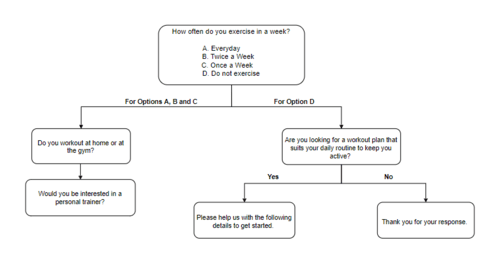
7.) Identifying New Potential Prospects
Surveys are also great for collecting information about interested clients that visit your website. Using skip logic, you can see if the visitors are interested in your products and pitch the correct sales information. You can also harvest upselling and cross-selling opportunities among the existing customers by posing the right questions.
Example:
- “Do you currently own a car?” Yes or No
- If Yes – “Which car do you use?”
- “What are the features that you like the most in your car?”
- “Are you looking to buy a new one or upgrade the existing one?”
- If Yes – “Which car do you use?”
- If No – “Are you looking for a car?” Yes or No
- If Yes – “Would you be interested in setting up a meeting to discuss your requirements?” Yes or No
- If Yes – “Please provide us some information to get started.”
- If No – “Thank you.”
- If No – “Thank you for the response.”
- If Yes – “Would you be interested in setting up a meeting to discuss your requirements?” Yes or No
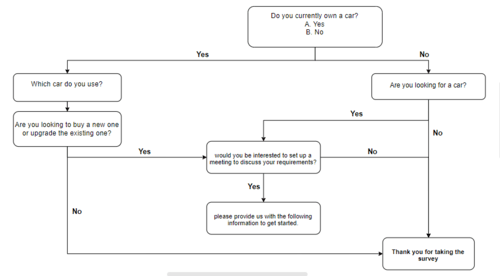
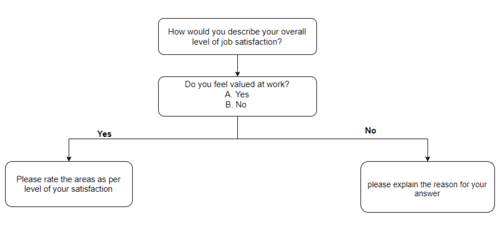
Read more: What Survey Questions Should I Ask?
FREE. All Features. FOREVER!
Try our Forever FREE account with all premium features!
Benefits of Using Skip Logic or Branching in Surveys
Coming back to the word we mentioned right at the beginning i.e. relevance. By now it must be clear to you how to skip logic or branching makes surveys less irritating for the respondents and makes them feel like they are being heard the right way, resulting in better completion rates and useful results. Here are a few more benefits that you can experience with this cool feature:
1.) Design Customized Surveys
One of the most significant benefits of using skip logic in your surveys is to make them appear customized to each respondent. When you add follow-up questions that resonate with the previous answer throughout the entire survey, it provides a much more focused and personalized experience. It improves customer engagement because the questions feel relevant to their experience.
For example: Look at the survey for a clothing website-
- Please specify your gender?
- Male
- Female
- Other
With skip logic, knowing the gender of the respondent opens up new opportunities to ask specific questions about their tastes, preferences, upcoming products, choices, etc.
If the person is a male, “Have you tried the new wallet collection? What do you think about it?”
If the person is a female, “Have you tried the new exclusive cosmetic range from L’Oreal on our website?”
Both of these questions are specific to different genders and cannot be asked to others. That is the power of skip logic.
Tip: Always mention the third option of “Other” or “Prefer not to say” for those respondents who do not identify as either of the two genders.
2.) Decrease Survey Abandonment
Survey abandonment is a critical issue. One of the reasons people abandon a survey is that it is either too long, poses personal questions, or questions that do not apply to them. Using skip logic, you can curate a logical path and shorten the completion time. These factors automatically reduce the chances of survey abandonment. Since your survey never becomes irritating or tedious for the respondents, they are less likely to get frustrated and leave before completing it.
Related Read: 30+ Proven Ways to Reduce Shopping Cart Abandonment
3.) Improve Question Relevance for Respondents
Since a survey with question branching takes the path according to respondents’ choices, it makes the questions appear more relevant.
For example:
- “Do you eat meat?” Yes or No
- If Yes – “How many times in a week do you eat meat?”
In a generalized survey, the second question becomes irrelevant for the respondents choosing ‘No’ as the answer.
Now, imagine if they have to face such questions at each step. It shows that the survey is poorly designed and does not take into consideration their responses. It may frustrate your respondents and cause survey abandonment.
With skip logic, irrelevant questions become practically non-existent for the respondents.
Must Read: 25 Best Online Survey Software
4.) Improve Data Quality
The hardest part of the survey strategy is making sure that the data is accurate and reliable. Personalizing your surveys using skip logic will allow you to streamline your datasets. By hiding the irrelevant questions, you can improve the quality of data collected from the respondents.
It also ensures the reliability of the feedback. If the respondents see the questions that do not apply to them, they may answer them at random or without consideration, which may skew the survey results. Branching helps you gather relevant results for accurate analysis so you can make informed decisions.
Related Read: 12 Survey Mistakes to Avoid
5.) Disqualify Unrelated Respondents
Not every visitor is your customer. With skip logic, you can disqualify the unwanted respondents or allow them to opt out of the survey without abandoning it. It saves both your and respondents’ time. Plus, it keeps the survey data clean by preventing non-objective responses from unrelated respondents.
Now the question is, how does it work?
For example, let’s say you want to disqualify the respondents below the age of 18 and above 60 from your survey.
Use the following introductory question:
- Please select your age
- Below 18
- 18-25
- 25-40
- 40-55
- 55-60
- Above 60
Using skip logic, you can direct the respondents who select the ‘below 18’ or ‘above 60’ as the response to the last step in the survey, which may be a “Thank You” message. You can also display the message, ‘You do not qualify for this survey’ and redirect them to another link.
What’s more, if you have a high number of disqualifications in a survey, you can use it as an indicator to check whether your survey is reaching the correct target audience or not.
6.) Shorten Survey Length and Increase Completion Rates
By preventing the respondents from seeing unnecessary questions, you can reduce the effective survey length. A shorter survey length means reduced chances of respondents getting frustrated and thus higher completion rates.
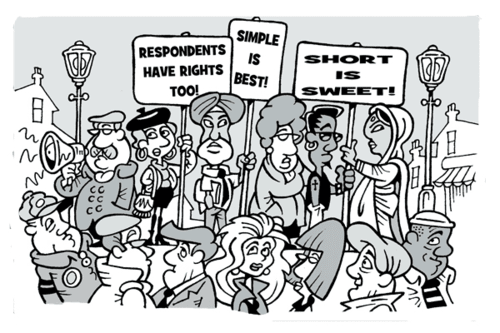
7.) Collect Different Feedback From the Same Survey
Branching logic makes it easier to incorporate different question types in the same survey to collect additional data sets. Here’s how it helps:
- It automatically segments the respondents and takes them to custom routes depending on the responses.
- This makes it easier to analyze the data and track each response thread separately.
- You can gather different actionable insights from different feedback and take necessary actions.
How to Design a Survey Using Skip Logic?
Step 1: Choose Survey Questions
The backbone of a survey is formed by the targeted questions you include in it. The questions you choose will determine the feedback you collect from the respondents. Your questions should be direct, simple, concise, and easy to understand.
Since you’ll use skip logic and branching, ensure that the questions succeeding the initial question should resonate with the response anchors. Try to personalize the follow-up questions with fillers and emphatic phrases to align them in tone with the responses.
For example, if the respondent selects a dissatisfied response, add a statement such as ‘we are sorry to hear that. Please let us know what frustrated you.’ Adding fillers and sentiments to the questions can work magic in improving customer engagement.
Once you have decided what questions you want to include in the survey, the next step is to figure out all the branches based on the responses.
Wondering what to ask? Check out and bookmark this useful library of survey questions to ask.
Step 2: Map out the Routes for Each Question
To ensure that the survey follows the correct sequence for each question, you need to map out all the possible survey branches. As shown in the figure below, create a visual representation of the routes that branch out of each question in the survey.
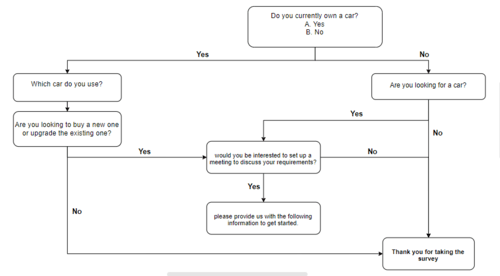
You can add conditional and unconditional branching as required. Mapping the routes beforehand will allow you to see whether the sequence of each path makes logical sense or not. You can change or modify the questions and their paths so that the survey feels personalized and well designed for all the respondents.
Step 3: Make Sure That the Survey Is Linear
While mapping out the routes, keep in mind that skip logic works only with linear surveys. Linear surveys are the ones that always move forward. It means the respondents will always start with question 1 to move to the nth question. They may skip questions that do not apply to them, but the perceptive survey flow is still forward.
In non-linear surveys, the respondents can answer questions in any order. Since there is no set answering sequence, you cannot know which question the respondent would answer first and cannot design a branching logic for these kinds of surveys.
Related Read: 7 Reason Why Survey is Important
Step 4: Design Your Survey
Now that you have the plan laid out on paper, it is time to start designing the survey. The easiest way is to first add all the question screens/pages to the survey and then add the branching nodes to the appropriate responses in each question.
Good survey tools include question branching features, making it easier to create and deploy surveys in minutes. You just need to mention the next question you want to show the respondent under the response, and it’s done. No coding is required. Some tools even allow you to design your own custom survey branching rules for better flow control.
Must Read: 12 Reasons to Conduct Employee Satisfaction Surveys
Step 5: Test the Survey
Testing is a very crucial part of design and implementation in any process. Deploying a half-baked survey may lead to survey abandonment. It can also produce inaccurate and unreliable results.
Testing your surveys will help you reveal unseen issues with the branching and measure survey effectiveness. It will let you understand whether the survey fulfills the intended objective or not. You can detect any broken routes and change the sequence if necessary.
Send your survey to different teams to test it out and make the adjustments before deploying it on your website, product, or app.
Step 6: Deploy the Survey
After successful testing, you are now set to deploy the survey. Identify the target audience and embed the survey in your website, app, or product at the desired locations. You can also send it out via email.
Once activated, it will allow you to collect the voice of the customer and gather actionable insights to improve customer experience on your product, website, or app.
Tips for Creating Effective Skip Logic Survey
- Always turn off numbering in your survey questions, so the survey takers do not see random changes in question numbers.
- For the same reason, remove the progress bar from the survey.
- Turn off backward jumps in the survey with skip logic.
- Make sure the survey is linear.
Never Skip the Skip Logic in Your Surveys
Whether you aim to collect product feedback or customer information, survey branching offers a plethora of solutions such as respondent segmentation, unique feedback, and in-depth information. The only hurdle is to design a targeted branching survey. If you are new to surveys, you can always select a tool that offers pre-built templates to create surveys with skip-logic. With this simple technique, you can optimize your surveys, give the respondents a better experience, and gather in-context feedback.
 Tips
Tips
We’d love to hear your tips & suggestions on this article!
FREE. All Features. FOREVER!
Try our Forever FREE account with all premium features!

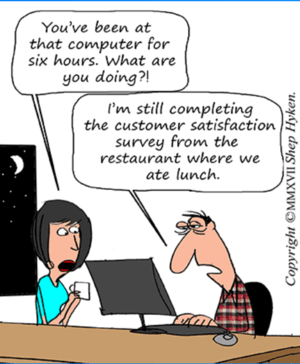
 We'd love your feedback!
We'd love your feedback! Thanks for your feedback!
Thanks for your feedback!




